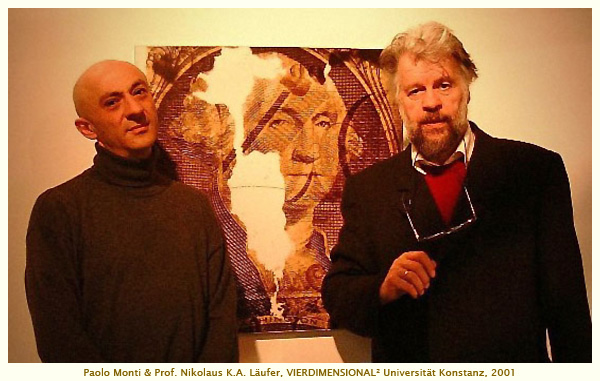|
1. Interpreting a decaying dollar note
The US-dollar note with the image of George Washington is
a symbol that allows for diverse interpretations. Each observer will select his
own. The choice, of course, will be influenced by the age and nationality of the
observer. In addition historical circumstances, his life experiences and
political attitudes also play a significant role.
A stained dollar note,
eaten away by liquid acid, in the first place stands for the sullied image that
the world has of the US since the war in Vietnam. For a patriotic American, this
picture is the expression of a wide-spread anti-Americanism and it reminds him
of the American flag, that was burnt over and over again in various parts of the
globe. For an American with an interest in monetary history, on the other hand,
the image is a symbol for the decay and loss of the domestic value of the
dollar. After all, the US currency has lost 85% of its domestic value over the
past 50 years.
My own preferred
interpretation of the „Dollar-Image“ is that of a symbol for the downfall of the
post war international monetary system. The Bretton-Woods system of pegged
exchange rates ended in April 1973 with the transition of the major industrial
countries of the Western world to flexible exchange rates. The world was no
longer prepared to let itself be swamped by American dollars. The flood was the
result of the special financing of the Vietnam war and the consequent deficits
of the American balance of payments. An inflationary wave spread from the US
affecting the whole world. This was the high time of international monetarism.
Economists were talking of a dollar-caused world inflation and constructed the
concept of world quantities of money, in order to explain world inflation. The
monetary base of the world quantity of money was the quantity of US-dollars put
into circulation by the US.
The resistence that
developed around the globe against the exchange of mere “paper” dollars for real
goods and interest earning assets may also be traced back to the fact that in
1971, two years before the breakdown of the Bretton-Woods system, the
convertibility of dollars into gold, which had existed for non-American central
banks, was formally eliminated by President Nixon (closing of the Gold window).
De facto, gold convertibility had been abolished and the world had already
settled on a pure Dollar standard some years before. The formal gold
convertibility was no longer effective and had become a mere window dressing for
the international monetary system. The end of the Bretton-Woods system was the
end of the Dollar standard.
Yet, actual historical
developments are not always perfectly in line with pronounced symbolic
objectives. Since the end of the Bretton-Woods system the dollar has not
disappeared from the international economic scene. As an international currency
the US-dollar is still important. We have just gotten a feeling of it again. The
crude oil market uses the dollar as a contractual currency. Any appreciation of
the dollar drives up our gasoline and oil-heating prices.
In recent years the
dollar has taken a surprising upswing. Several countries have abolished their
own national currencies and have introduced the US-dollar as a legal means of
payment. Panama has been using the US-dollar as a national currency since 1904.
Ecuador made this step just last year, i.e. in 2000. El Salvador, Argentina and
other countries, among them some eastern countries like the Ukraine, who in the
recent past have suffered from strong home-made inflations, are likewise
considering the transition to the US-dollar as a legal means of payment in their
own country.
American politicians are
already dreaming of a dollarisation of the whole world and try to sell the
US-dollar as a solution for all stability problems. (Among the more active
participants in this dream we find the American senator Connie Mack. Well known
academic economists, like Richard Cooper, also support this idea.) It goes
without saying that this would be a really profitable development for the US:
virtually worthless paper or simple entries in computer files would be exchanged
against real goods and interest bearing promises to pay. Future seignorage gains
would accrue in Washington. This result would correspond to the well known
dictum: Those who have, shall be given more. To a certain extent such activities
on the part of the US are a reaction to the introduction of the Euro in Europe.
(In former communist countries, we see a competition between the DM (now Euro)
and the US-dollar.)
2. Paolo Monti’s
relation to some problems in monetary theory
Inflation and failures
of monetary systems are signs of disintegration or decay, which in general are
valued negatively. But there are positions in monetary theory, which consider
the loss of real money value a positive phenomenon. Long before the Great
Depression in the 1930’s the idea had developed that economic crises and
depressions might be explained by deficiencies in the demand for commodities and
that such phenomena could be eliminated and avoided by stimulating aggregate
demand for economic goods.
According to some
economic circles, deficiencies in the demand for commodities were caused by the
hoarding of money as a result of which currency was withdrawn from active
economic circulation. Theorists concluded that if hoarded money were
systematically to lose value, people would consequently abstain from hoarding.
In this way, unemployment and cyclical downturns could be avoided. The
originator of the Schwundgeldthese, ie: “stamped” money theory, was the Austrian
Silvio Gesell, a successful business man, who made his fortune in South-America.
Even before his return to Europe, he was concerned with economic problems.
(“Stamped” money, the term used by Keynes for Gesell’s idea, does not exactly
match the connotations of Gesell’s more general German term Schwundgeld.
“Stamped” money is, more specifically, money that loses its nominal value over
time if not restamped periodically, against a user fee, according to a
predefined programme.)
Until the Great
Depression, in economic circles Silvio Gesell was considered “crazy” and an
outsider. However, this suddenly changed when John Maynard Keynes published his
epoch-making book “The general theory of employment, interest and money”. In the
penultimate chapter (Chapter 23) of this book Keynes deals with the ideas of Silvio Gesell. According to Keynes the idea behind “stamped” money was
economically sound and its application would contribute, more than the ideas of
Marx, to overcome depression and to abolish unemployment. Gesell’s followers
were very bucked and felt highly honoured by Keynes assessment. Today, they
still pride themselves of Keynes evaluation, as can be seen by following
internet-pages on which Gesellians carry on their fight for the distribution of
Gesell’s ideas. (Prior to Keynes, Irving Fisher, alone among academic
economists, had recognized the significance of the idea.)
How does this relate to
the artistic work of Paolo Monti?
Paolo Monti is not an economist and until
recently he did not know anything about “stamped” money as proposed by Silvio
Gesell. Despite this in his work he has unconsciously developed a solution to a
problem inherent in Gesell’s notion of “stamped” money . The chemical processes,
to which Paolo Monti exposes money and by which this disintegrates and finally
dissolves, represent the Geldwertschwund, ie: depreciation or decay of money
requested by adherents of the Stamp Scrip concept.
According to Gesell a
constant «Geldwertschwundrate», that is, rate of depreciation or decay of money
would be a permanent stimulus for the demand for commodities. This conclusion
represents, however, a major defect of the “stamped” money concept. Today we
know that one cannot expect a permanent rise in demand for goods from a constant
fall in the supply of money. If, in fact, the rate of decay of money is raised
from zero to some positive value, then the demand for real money stocks will
fall below the available stocks. Un-hoarding of money starts. However, this
de-hoarding will only last until actual (real) money holdings have reached the
targeted level corresponding to the new rate of currency decay, whereby the
greater the rate of decay, the lower will be the desired quantity of money, that
is, level of money hoarding. For the resulting stimulus for the demand for
commodities to become permanent and not merely a transitory phenomenon, the
currency decay rate cannot be held constant but must gradually increase over
time.
The rate of decay of
money in Paolo Monti’s work is a function of the agent’s (observer’s) behaviour.
In addition it is no longer exogenous and constant but endogenous and variable.
By varying his distance to the process of decay the observer accelerates or
decelerates the rate of decay. A reduced distance indicates intensified hoarding
and a corresponding acceleration in the rate of decay. On the other hand, a
greater distance to the process of decay signifies decreased hoarding and a
slower process of decay. Apart from the aesthetic considerations, Paolo Monti’s
work represents the model of a servo-mechanism for the hoarding of money without
the defects resulting from exogenous and constant rates of decay.
Unfortunately, the
followers of Silvio Gesell have neither acknowledged the defect in their thesis
nor have they come anywhere near a solution of the problem. (This defect was
also unknown to J.M. Keynes. Its discovery is the result of more recent
developments in macroeconomics following the revolutions of Monetarism and of
Rational expectations in the late 1960s and mid 1970s, respectively.) Gesellians
tend to consider the academic world as a conspiracy of evil-minded half-wits or
corrupt servants of money capital, who refuse to acknowledge the positive
results observed when the Stamp scrip concept has been put into practice, as in
Wörgl, Austria during in the 1930s. Gesellians neglect that this empirical
example actually confirms only the short term effectiveness of their policies,
since the Austrian experiment was stopped after a few months. Had this not
happened, the defect described above would have become apparent (The Austrian
Central Bank regarded the Wörgl “stamped” money experiment as an interference in
its constitutional competences and put an end to the experiment by means of an
High Court order.)
 Since the 70s of the
last century Keynesianism has lost political ground. Together with this the
“stamped” money concept has likewise lost importance. There is no doubt that
Paolo Monti’s processes of decay also represent the fate of theoretical and
political ideas. Since the 70s of the
last century Keynesianism has lost political ground. Together with this the
“stamped” money concept has likewise lost importance. There is no doubt that
Paolo Monti’s processes of decay also represent the fate of theoretical and
political ideas.
Dr. Nikolaus K.A. Läufer
University of Constance,
December 17th, 2000 |
